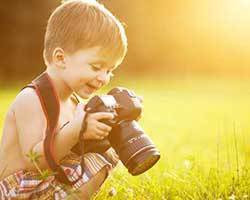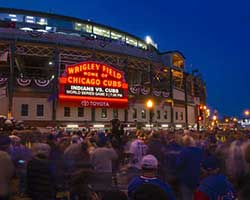It's pretty exciting that the new wave of DSLR cameras allow us to photograph in very low light with little grain. As a wedding photographer, I love that I now have couples requesting a portrait session after the sun has set.
Metering
Step 1: If you don’t have a light meter, you can use your camera. You'll want to set your camera up so it is in spot meter mode (not matrix). This will allow you to measure a tiny amount of light hitting your subject.
Step 2: Meter a grey card so it picks up the brightest spot of light. Fill your frame with the grey card to determine the exposure.
Step 3: Place your subject so it is hit by the light you just metered.
This kind of image is done to taste, so if it doesn'’'t look right, adjust your exposure until you like what you see.

There was a break between dinner and speeches, and I asked Chris and Karen if they would like to spend no more than five minutes doing a night portrait. I tested the light and had my exposure determined before I put them into the scene. This is the entrance way to an outdoor bathroom at their reception. You can make out the “W” for “Women.” I had a crowd of people behind me wondering what the heck I was doing. When I showed them the back of the camera, they couldn't believe it. That's because this image is under exposed by about two stops from what the scene looked like. If I had taken the picture in matrix mode, exposing for the whole scene, the shadows would not be black, and it would be obvious that this was the entrance to a bathroom. Changing the exposure and metering only for the brightest spot of light can make your images go from ho-hum to dramatic. For light like this, it's important to have your subject angle her face towards the light; otherwise there will be unflattering shadows in the eyes. I told Karen it was okay to keep her eyes closed. I then told Chris to kiss her along the front of her neck.

Most elevators have some sort of interesting lighting. I always follow the bride (or the bride and groom) when they ride in one. If I have the couple to myself, I'll ask them to pose for a very quick portrait while we're on our way somewhere else. Because the pot light here is so directional and bright, it means Cara is lit, but the rest of the scene is almost black. My eyes saw the scene about two stops brighter than it looks here in the photograph. Don't be afraid to lose details in the shadows. Notice that you don't always need a super high ISO to create this kind of visual effect.

This is the same elevator scene. I added the groom and underexposed by one additional stop, making the shadows go totally black. I told Steve to kiss her along her neck. Again, I asked Cara to angle her face towards the light. If it's too bright, I always tell my subject to close her eyes and enjoy the kiss. By metering only for Cara's face, the image looks like it could have been shot in a studio.

This is the balcony outside of Keisha and Garrett’s reception. It’s just a regular incandescent outdoor light bulb, but it is bright enough to light Keisha’s face.

This is the outside of a shopping mall. The scene was a lot brighter than this, but, by metering for the brightest point of light, I was able to ensure the shadows went almost black. It’s okay that some of the details of Noelle and Nicholas’s attire lose some detail.

You would never know this image was taken in a parking garage. There was a pot light, and I used the same techniques as above to take a close-up portrait. The brightest spot of light is hitting Maria’s cheek, nose and forehead.

If your couple is getting married in a beautiful place, the best way to show it off is to turn off your flash and shoot wide. I asked the Kelly to show a bit of leg, just to add some drama to the pose. The next time you're at a venue, squint and look for the brightest light. In this case it was the entrance. If they were at the top of the stairs, I would have needed to find a way to kick in more light on them. The entrance was lit by a simple incandescent light, albeit brighter than the other incandescent lights, hence the high ISO.
Using the available light allows you to capture shots that have impact, even in dark settings.
Interested in taking your photography to the next level? Try a photography course with NYIP.






